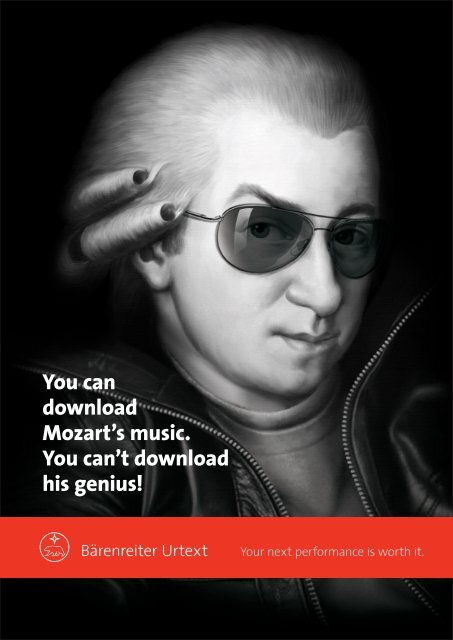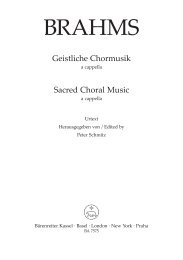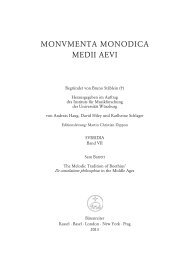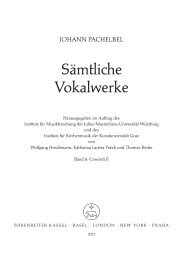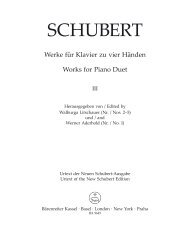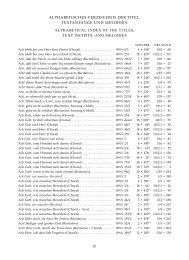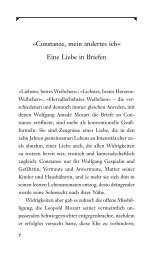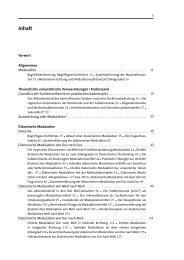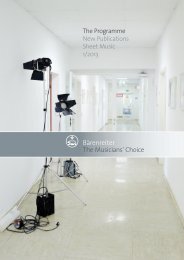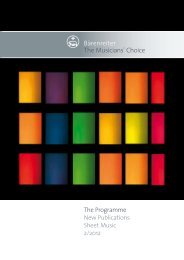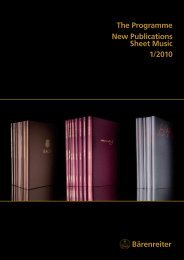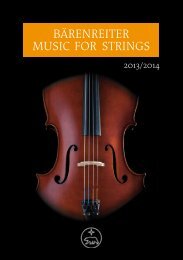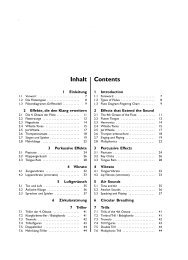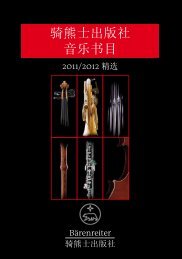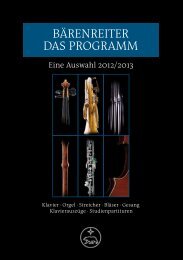Urtext Brochure - Bärenreiter Verlag
Urtext Brochure - Bärenreiter Verlag
Urtext Brochure - Bärenreiter Verlag
Create successful ePaper yourself
Turn your PDF publications into a flip-book with our unique Google optimized e-Paper software.
You can<br />
download<br />
Mozart’s music.<br />
You can’t download<br />
his genius!
“ After so many<br />
cantatas I only<br />
play for fun.<br />
My original work<br />
is for the fans.”<br />
But what is<br />
an urtext edition?<br />
Bärenreiter <strong>Urtext</strong>:<br />
Your next performance<br />
is worth it.<br />
Think of the time you spend practising and rehearsing<br />
for lessons and concerts. Can you really be sure that the<br />
music you play from reflects what the composer wanted?<br />
Indeed, works have always been edited reflecting the<br />
taste of the time, often leading to a gradual deviation<br />
from what the composer had in mind. Most copied<br />
or downloaded music comes from old, heavily edited or<br />
even faulty editions. How disappointing to realise that<br />
you have wasted your time and energy on a musical text<br />
you cannot trust.<br />
With Bärenreiter <strong>Urtext</strong> editions you can have confidence<br />
in the validity of the musical text.<br />
At Bärenreiter the label “urtext” describes a scholarlycritical<br />
edition based on all known sources.<br />
In the past, it has often been difficult for musicians<br />
to really know if what they were playing was true to<br />
the composer’s intentions. Publications were heavily<br />
elaborated with editors’ own – often questionable –<br />
additions and interpretations. In order to adequately<br />
judge the quality of an edition, musicians would need<br />
to examine manuscripts and sources themselves.<br />
Bärenreiter takes on all this background work for you,<br />
our aim being to produce urtext editions reflecting<br />
the latest musicological research. Our editors, experts<br />
in their field, strive to set down a work as closely as<br />
possible to the composer’s intentions. This isn’t as easy<br />
as it sounds. Bärenreiter’s musicologists often have<br />
to travel around the world to track down sources for<br />
a composition. They work like detectives, deciphering<br />
manuscripts which are sometimes almost illegible<br />
and evaluating conflicting sources.
Debussy, Sonata for<br />
Violoncello and Piano,<br />
page from composer’s<br />
autograph<br />
Debussy, Sonata for<br />
Violoncello and Piano,<br />
m. 18, Bärenreiter<br />
<strong>Urtext</strong> edition BA 9412<br />
6<br />
17 <br />
<br />
Mouv t t<br />
Isn’t urtext just a copy<br />
of the autograph?<br />
As a musician you certainly can appreciate how<br />
difficult it can be to grasp what the composer actually<br />
intended, especially when we have no recordings of<br />
the performances. Simply looking at the autograph –<br />
assuming it exists – is not enough. What if the composer<br />
made corrections in the first printed edition? Obviously<br />
in this case the autograph only provides part of the<br />
story of a composition. As many sources as possible<br />
need to be assessed in order to compile a Bärenreiter<br />
<strong>Urtext</strong> edition including sketches, letters, autographs,<br />
manuscript copies, proofs, first editions, first editions<br />
with autograph corrections, contemporary reviews<br />
and comments by contemporaries.<br />
No cost or effort is spared by Bärenreiter when it comes<br />
to amassing and piecing together all the available<br />
information. An indispensable part of every urtext edition<br />
is the critical commentary where all editorial decisions<br />
and discrepancies between the sources are meticulously<br />
recorded. Only in this way can the true genius of the<br />
composer and his work be revealed.<br />
17 <br />
p<br />
<br />
<br />
Mouv<br />
What else can I expect<br />
from a Bärenreiter <strong>Urtext</strong><br />
edition?<br />
A trustworthy musical text alone does not yet justify<br />
<br />
<br />
<br />
<br />
<br />
<br />
<br />
sf<br />
<br />
<br />
<br />
the label Bärenreiter <strong>Urtext</strong>. Integral parts of Bärenreiter<br />
<strong>Urtext</strong> editions are:<br />
• Information on the genesis and history of the work<br />
• A description of the sources<br />
• Valuable notes on performance practice<br />
• A critical commentary explaining all source<br />
discrepancies and editorial decisions.<br />
22 <br />
<br />
<br />
sf<br />
<br />
<br />
<br />
<br />
<br />
<br />
<br />
<br />
<br />
<br />
25<br />
p<br />
p<br />
f<br />
But it’s not all about musicology. Bärenreiter also satisfies<br />
your practical needs as a performer. Bärenreiter <strong>Urtext</strong><br />
editions offer:<br />
• Page turns, fold-out pages, and cues where you<br />
need them<br />
• For solo string works additional parts with fingering<br />
and bowing<br />
• In the case of solo concertos and vocal scores<br />
straight-forward piano reductions<br />
• A well-presented layout and a user-friendly format<br />
• Excellent print quality<br />
• Superior paper and binding<br />
• Solid, “Made in Germany” quality<br />
Fuoco<br />
arco<br />
<br />
<br />
<br />
Fuoco
Debussy, Sonata for<br />
Violoncello and Piano,<br />
composer’s sketch<br />
Let’s take this as an<br />
example<br />
<br />
Cédez<br />
*)<br />
o<br />
//<br />
pp<br />
<br />
<br />
<br />
<br />
pp<br />
<br />
<br />
<br />
<br />
<br />
<br />
<br />
pp suivez<br />
<br />
Cédez<br />
<br />
3<br />
<br />
t<br />
Mouv<br />
pizz.<br />
<br />
<br />
<br />
<br />
<br />
pp<br />
<br />
suivez<br />
<br />
<br />
<br />
pp<br />
<br />
<br />
<br />
<br />
<br />
<br />
<br />
<br />
<br />
p<br />
<br />
<br />
<br />
p<br />
<br />
<br />
Mouv t <br />
sempre<br />
<br />
<br />
<br />
p<br />
<br />
<br />
p<br />
<br />
<br />
<br />
<br />
What does the word<br />
urtext mean?<br />
p<br />
<br />
pizz.<br />
<br />
Mouvt<br />
<br />
pp<br />
Cédez Mouv<br />
<br />
<br />
p<br />
<br />
<br />
<br />
<br />
<br />
<br />
<br />
<br />
<br />
Cédez //<br />
<br />
mf<br />
<br />
Cédez<br />
//<br />
<br />
<br />
<br />
<br />
The German prefix ur- literally means “original” or<br />
“earliest”. The earliest use of the term urtext goes back<br />
to the 19th century where it appeared in connection<br />
with literary texts. It referred to the original texts of<br />
writers such as Goethe or Shakespeare which scholars<br />
tried to restore and free from editorial additions.<br />
<br />
<br />
<br />
suivez<br />
t<br />
Mouv t<br />
<br />
<br />
<br />
<br />
<br />
<br />
p<br />
<br />
<br />
<br />
<br />
p<br />
p<br />
<br />
<br />
<br />
<br />
<br />
<br />
pp<br />
<br />
<br />
<br />
p<br />
<br />
<br />
<br />
<br />
<br />
<br />
p<br />
Cédez //<br />
<br />
<br />
<br />
<br />
<br />
<br />
<br />
p<br />
<br />
<br />
<br />
<br />
In music urtext now is a label used for scholarly-critical<br />
editions based on all known sources.<br />
<br />
Cédez<br />
Cédez<br />
<br />
<br />
<br />
<br />
<br />
//<br />
<br />
molto<br />
<br />
<br />
<br />
arco<br />
<br />
Mouvt<br />
p<br />
<br />
<br />
3<br />
mf<br />
<br />
Cédez<br />
<br />
//<br />
<br />
<br />
3<br />
3 3 3<br />
Cédez //<br />
<br />
If we take Claude Debussy’s late masterpiece, his Sonata<br />
for Violoncello and Piano from 1915, we have no less<br />
than 11 sources and this does not even include his<br />
correspondence. These sources comprise several copies<br />
of the work given by the composer to friends with<br />
annotations, but the primary sources are the sketches S ,<br />
the autograph score<br />
A , and the first edition E .<br />
The first edition very closely follows the autograph but<br />
there has always been a misunderstood symbol in the<br />
cello part (movement 2, measure 18). All other editions<br />
of this sonata present this symbol<br />
o as an open string.<br />
But is this correct?<br />
The final note in the bar is the lowest note on the cello,<br />
the open C string. There is no reason whatsoever for<br />
the composer to have indicated the open string with<br />
o as the tone can only be executed as an open string.<br />
What if Debussy intended a different execution with the<br />
symbol<br />
o? If this were the case what could it be? Other<br />
than an open string it could mark a harmonic – but for a<br />
harmonic he employs the traditional symbol of a diamond<br />
shaped head ◊ in the same movement in mm. 8–9.<br />
Looking at Debussy’s autograph, we find no answer<br />
to this question. But going back one step in the<br />
chronology of the work and looking at the sketches<br />
for the composition we find a circle above the note in<br />
question and in addition the word pizz. written above it.<br />
This pizzicato has never been published and thus never<br />
been performed.<br />
For the first time the Bärenreiter <strong>Urtext</strong> edition gives<br />
justice to Debussy’s intention.<br />
<br />
<br />
Mouv<br />
t<br />
<br />
<br />
This shows one of many examples that Bärenreiter <strong>Urtext</strong><br />
is not simply a copy of the autograph or a re-engraving<br />
of the first edition; it represents a thorough examination<br />
of all aspects of a work enriching our understanding of it<br />
with conclusive results.
“ I like the digital<br />
age, but nothing<br />
compares to<br />
the original.”<br />
Think of your<br />
next performance<br />
With print-outs from downloads you miss out.<br />
Your performances miss out.<br />
Don’t waste time by messing with loose paper copies.<br />
Build your personal music library with Bärenreiter <strong>Urtext</strong><br />
editions. Make our editions your own. Take advantage<br />
of our expertise and complement it with your personal<br />
markings and comments which you will be able to refer<br />
to all your life.<br />
Make a Bärenreiter <strong>Urtext</strong> edition a life-time investment.<br />
Your next performance is worth it.<br />
The Bärenreiter film …<br />
Renowned conductor and musicologist Christopher<br />
Hogwood takes you on a journey through Bärenreiter.<br />
Come with us behind the scenes.<br />
You will be given an insight into the editorial and<br />
production process of a Bärenreiter <strong>Urtext</strong> edition.<br />
The history of this family-owned company is also<br />
revealed.<br />
at www.baerenreiter.com
Designed by DW Cre8tive and take off – media services<br />
Your specialist in Bärenreiter <strong>Urtext</strong>:<br />
Bärenreiter-<strong>Verlag</strong> · Karl Vötterle GmbH & Co. KG · 34111 Kassel · Germany<br />
www.baerenreiter.com · info@baerenreiter.com · Printed in Germany · 1/1304/60 · SPA 101_7


